State Of Remote
How remote workers from around the world feel about remote work, the benefits and struggles that come along with it, and what it’s like to be a remote worker in 2019.
The State of Remote Work is Buffer’s annual report that showcases the world of remote workers and seeks to understand them. We asked nearly 2,500 remote workers to tell us about the benefits and struggles that come with remote work, what remote work looks like in their individual experience, and the structure of their companies that allowed for remote work in the first place.
We teamed up with other companies who are either fully remote or support remote work, to make this report possible. Thank you to our partners from Doist, HubStaff, Remote-How, RemoteYear, Trello, Workfrom, and We Work Remotely who helped to make this report possible!
Read on to dig into all of the insights about what it’s really like to be a remote worker in 2019.
Remote work is not a trend — it’s here to stay.
Of our respondents, 99% said they would like to work remotely at least some of the time for the rest of their careers. This is a notable stat to have discovered; while remote work is sometimes portrayed as a trend, these results seem to infer that this way of working is here to stay. Out of all the data we collected, no response was as powerful as this one.
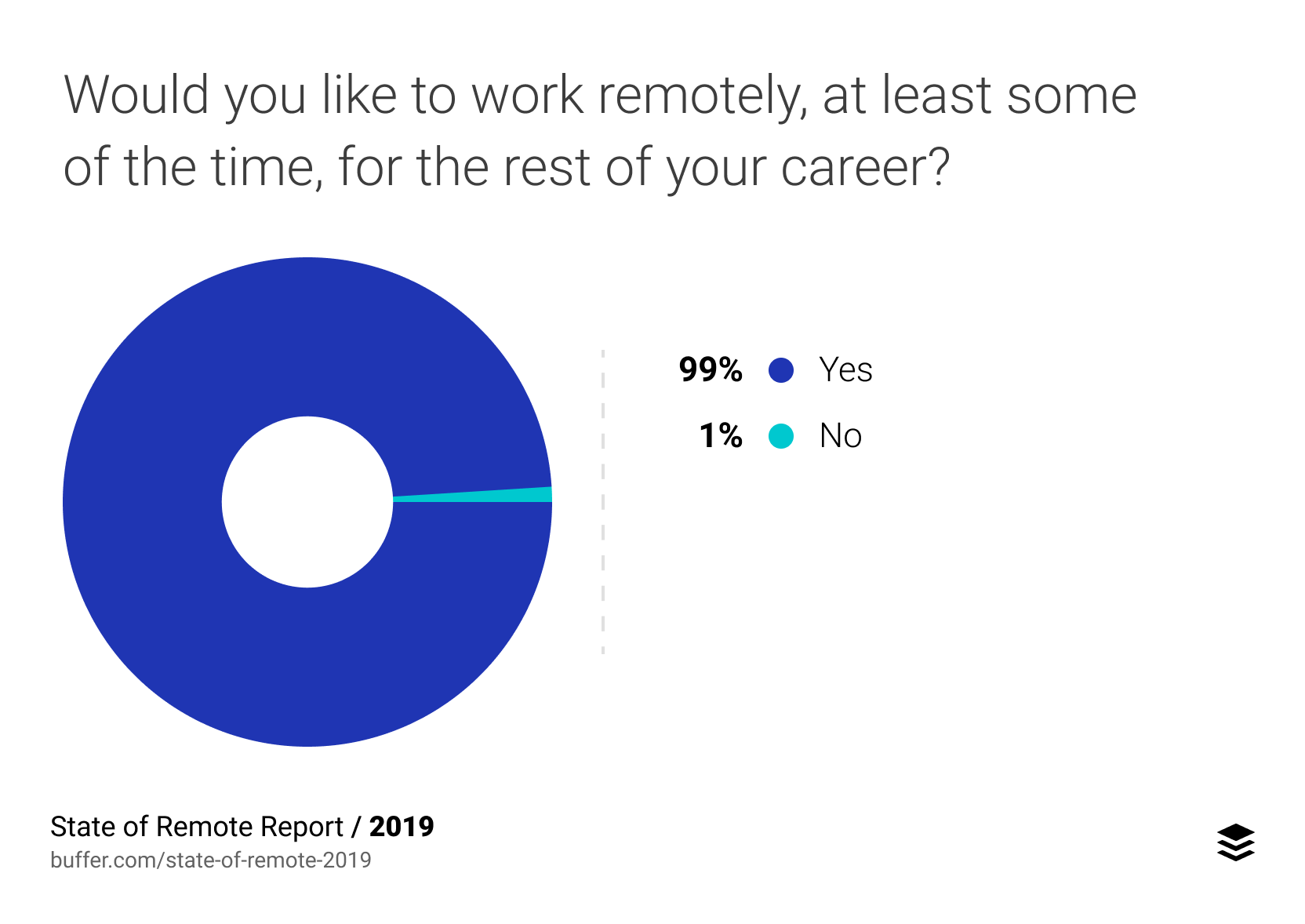
In addition to respondents wanting to continue to work remotely, they also recommend remote work to others in their lives, from coworkers and friends to family members.

According to Matthew Hollingsworth, the Director of Operations at We Work Remotely, the largest community on the web to find and list remote jobs, remote work may even become the norm. He says, “we truly believe now is the time for remote work to become the norm. We see hundreds of thousands of qualified people come to WWR each month looking for remote work and have seen the companies that embrace it leading the way in attracting the best talent.”
A flexible schedule is the biggest benefit to remote work.
Ever wonder why some people are longing to get into — and stay in — remote work?
Walking the dogs instead of commuting, that mid-morning gym session, the freedom to catch up with friends and not having to schedule time off for appointments. These are just some of the ways remote workers can enjoy a flexible schedule. Forty percent of respondents rate this is the biggest benefit of remote work.
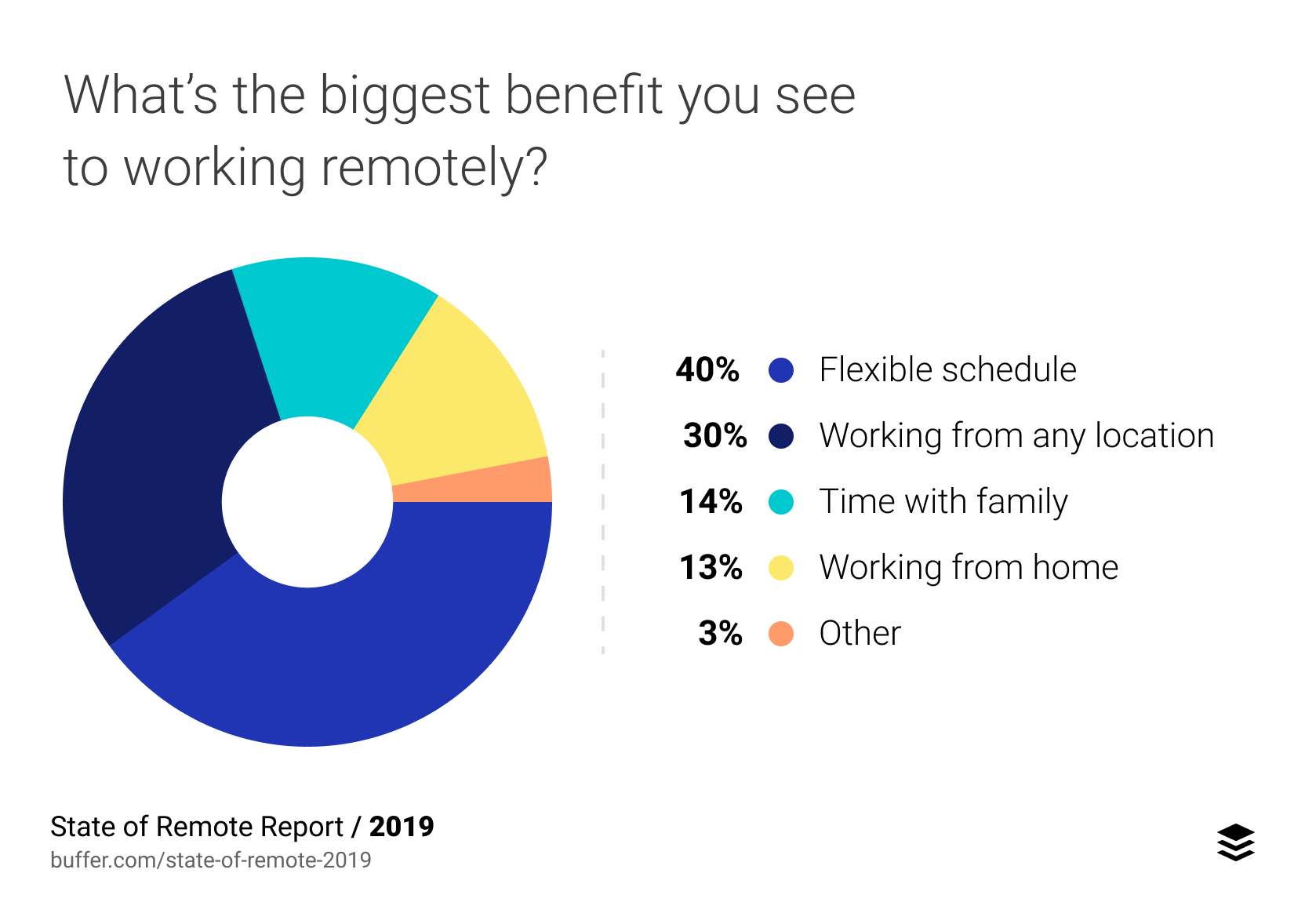
Iwo Szapar is the CEO and co-founder at Remote-how, an online platform empowering the growth of remote work through education and community. He believes remote workers enjoy this flexibility because “employees in their 20s and mid-30s value meaningful experiences more than possessions, and they want to be able to pay attention to all the important aspects of their lives.”
He also asserts that a flexible schedule is not only good for employees but employers as well. “Having a flexible schedule allows employees to juggle between work, hobbies, and time with friends, resulting in a positive work-life balance and also reducing workplace stress,” Szapar says.
Remote workers struggle with unplugging.
Remote work isn’t always as Instagram-worthy as it may seem. In fact, many remote workers struggle with unplugging from their work, loneliness and communicating.
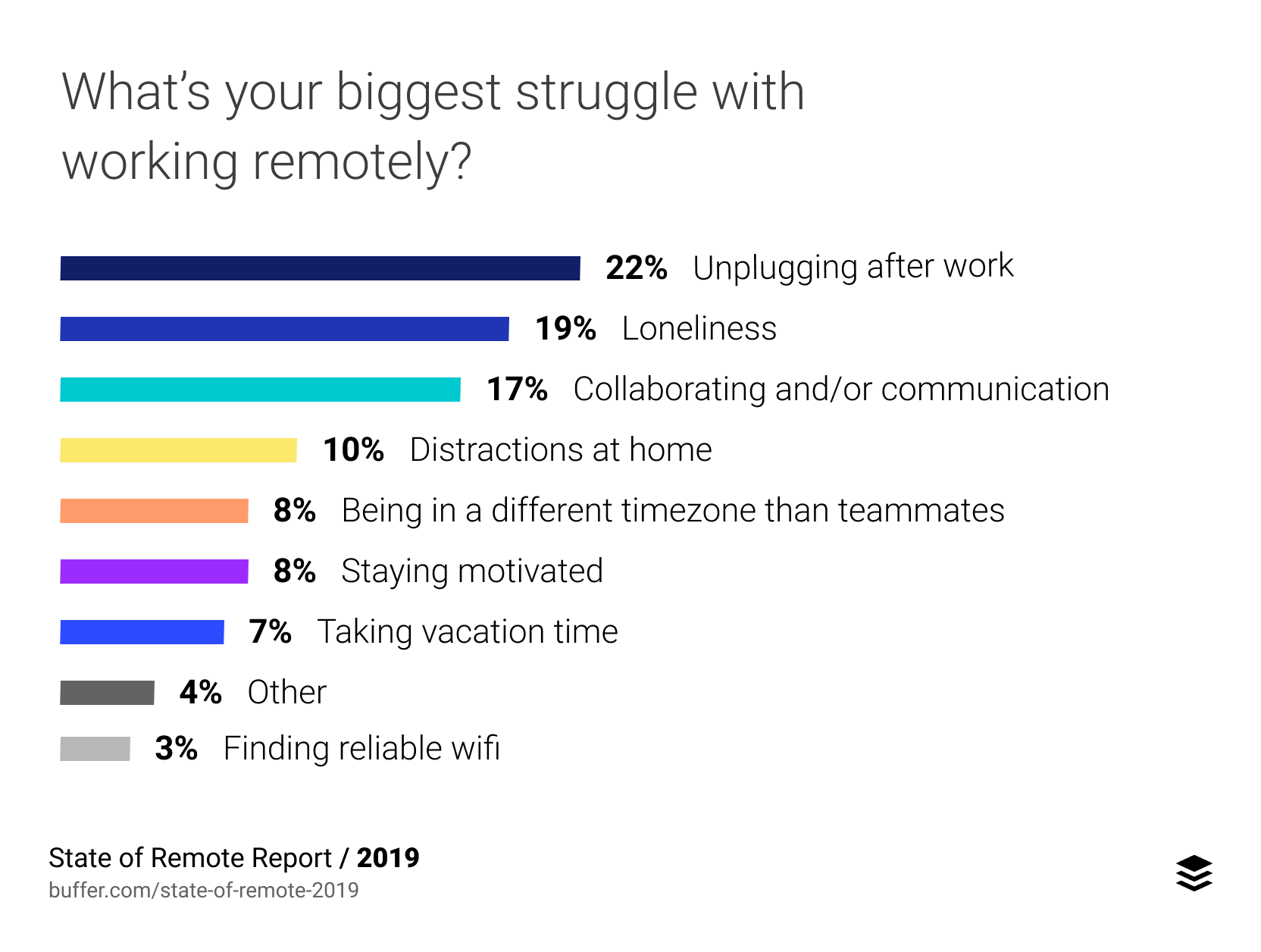
Amir Salihefendic is CEO of Doist, the fully remote company behind popular to do list app and task manager Todoist. After seeing these statistics, Salihefendic stated that “remote work isn’t just a different way to work – it’s a different way to live. And, unlike what you might see on Instagram, working remotely doesn’t mean you jet set to exotic locations to drink piña coladas on the beach.” He goes on to describe the less seen side of remote work, “we need to acknowledge that isolation, anxiety, and depression are significant problems when working remotely, and we must figure out ways and systems to resolve these complex issues.”
Most remote workers have unlimited vacation, yet take 2-3 weeks of vacation per year.
While only 7% of remote workers selected taking vacation time as being a struggle for them, this has been an important discussion point for remote workers. Notably, because the flexibility that remote work offers occasionally means that remote workers can work while traveling and don’t necessarily need to take vacation time to travel.
Vacation practices vastly vary by organization, by country, and by culture. Looking at how much vacation time remote workers are offered by their company each year, the most popular response to this question revealed that 32% of remote workers actually get unlimited vacation.
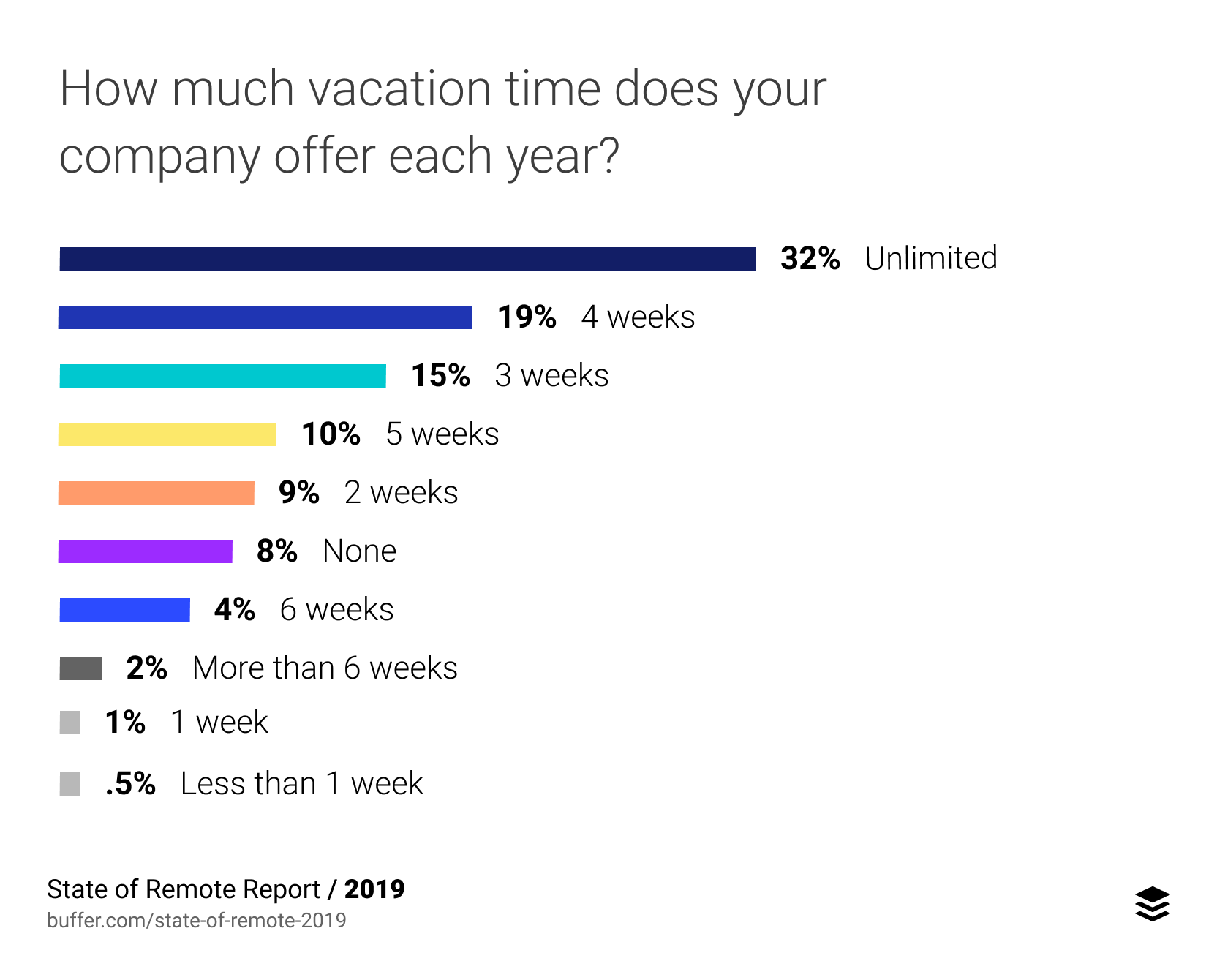
We also dug in a bit deeper to learn how much vacation time each remote worker had taken in the last year and learned that 43% of remote workers took between 2-3 weeks of vacation time, with an additional 20% selecting options between no vacation and one week per year.

Of those respondents who had selected that they have unlimited vacation, 44% stated that they take between two and three weeks of vacation each year. A further thirteen percent took one week or less of vacation per year, and 3.2% even selected “none” as the amount of vacation they took.
Remote workers may have location flexibility, but they love to stay home.
Remote workers can often work from anywhere, so where do they choose to go?
Interestingly, 84% of respondents told us that, most of the time, they’re working from home. A much smaller percentage of remote workers primarily work from coworking spaces (8%), coffee shops (4%), libraries (0.5%) and other places (3%) including five RV campers, hotels, offices, and a grandma’s basement.
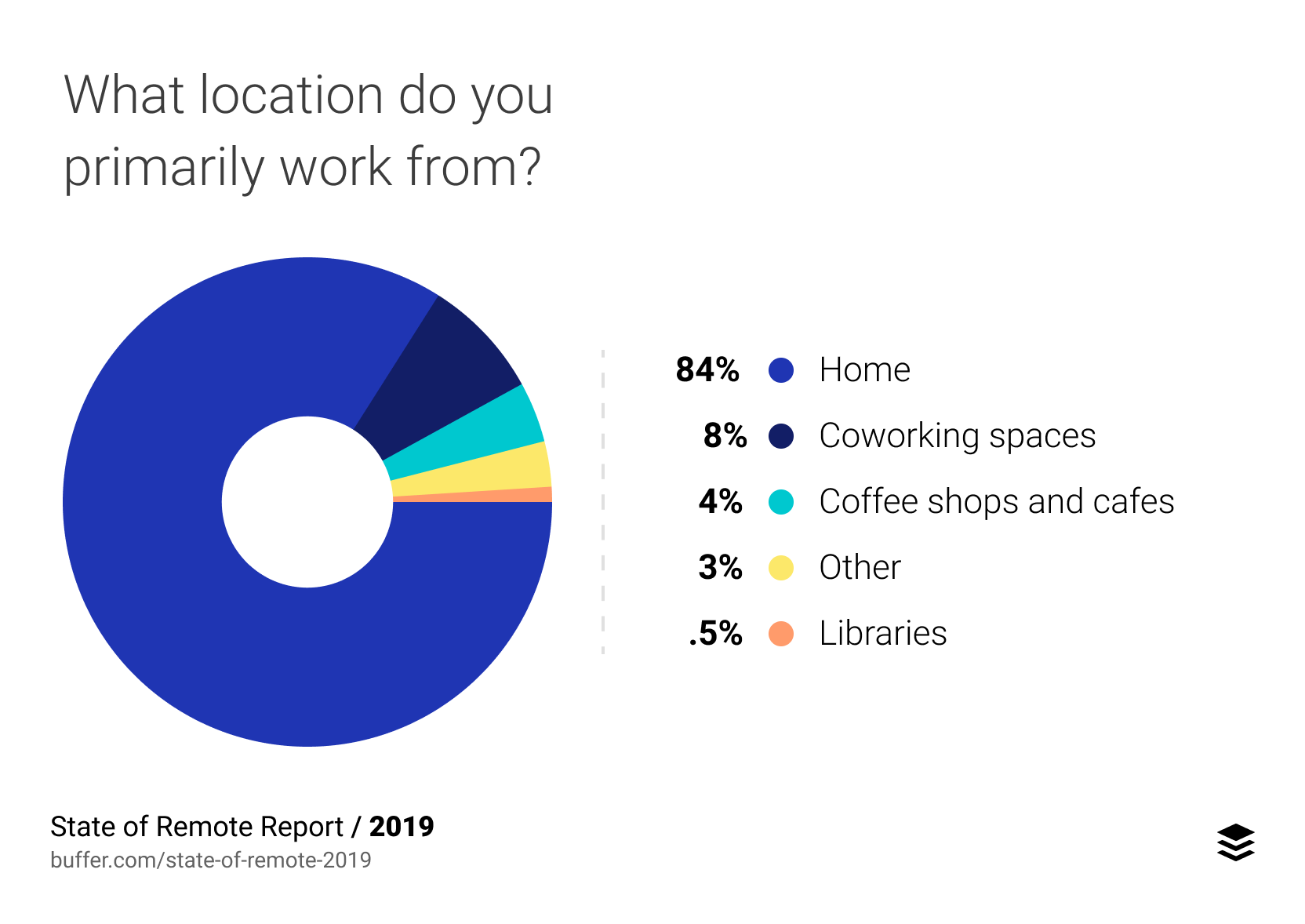
This is up from last year’s 2018 State of Remote Work, when we found that 78% of remote workers use their home as their primary work location.
Darren Buckner understands why remote workers continue to choose home. As the CEO of Workfrom, the world’s largest recommendation engine for remote workers to find trusted spaces to work, he’s found that “the convenience of working from home simply cannot be rivaled, and it continues to be the primary workspace choice for remote and independent professionals. In fact, most office-optional professionals spend upwards of 4 days working from home each week.”
With 37% of respondents, the second most common location for remote workers to work from is a coffee shop or cafe. Interestingly, 21% selected “not applicable,” which we presumably take to mean that they don’t work anywhere except their primary location.
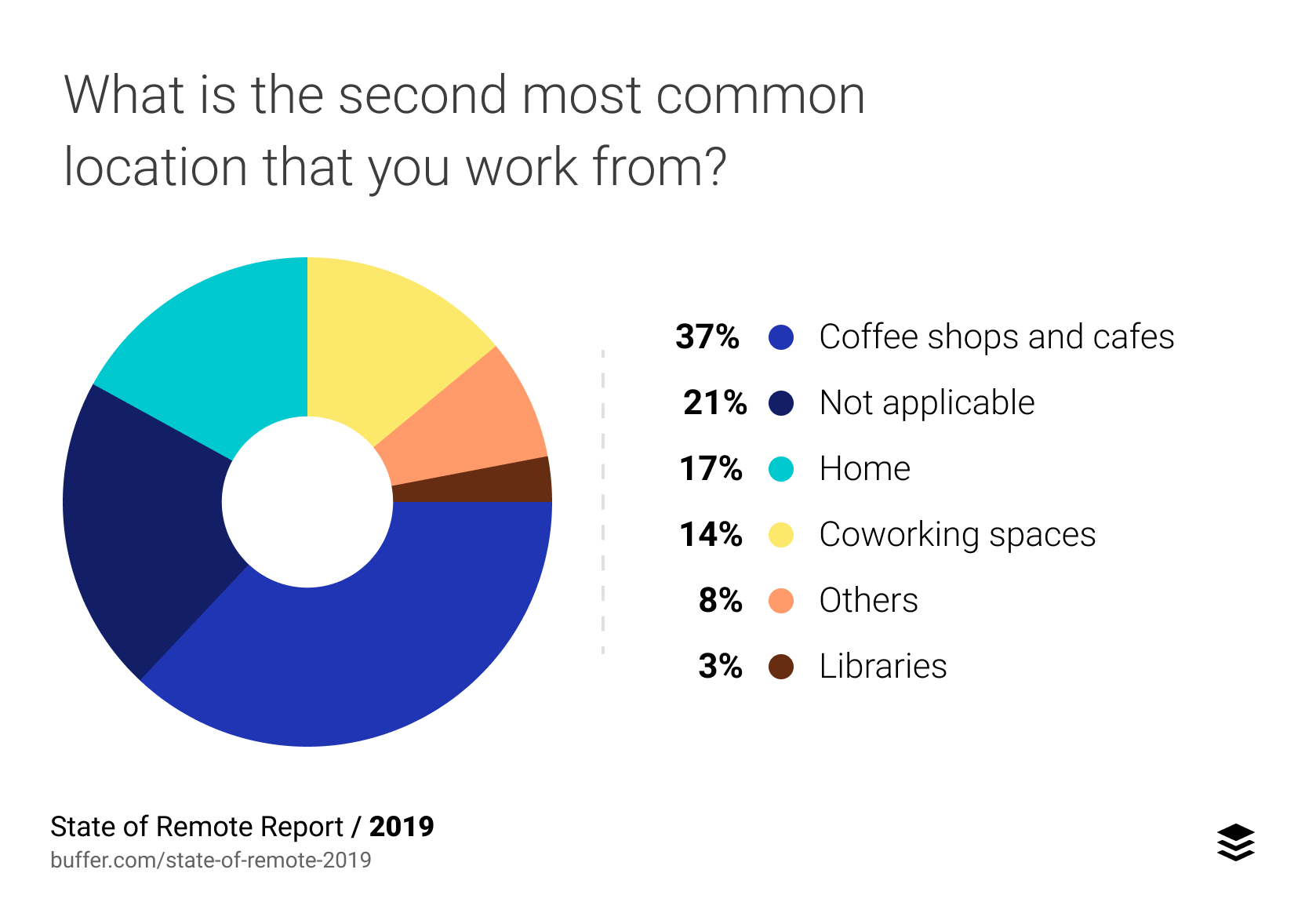
On this, Buckner says, “Convenience features prominently in these decisions. Coffee shops and cafes are located in many neighborhoods, require no setup or memberships to get started, and of course, there’s the quick access to an ambiance conducive to productivity (e.g., coffee, background conversations, and natural light).”
Most remote workers have traveled and worked at the same time.
The flexibility that remote work affords has increased the opportunity for travel. In fact, 44% of remote workers travel while working between one week and one month per year, and 25% of respondents do this work/travel combination more than one month of the year. Only 7% responded that they never traveled and worked at the same time.

Greg Caplan is the CEO of RemoteYear, a company that allows remote workers to travel while working around the world for a year or four months. Caplan believes that this is a natural progression as remote work becomes increasingly common. “As more and more companies are offering flexibility and more and more people are now working remotely, lots of them will want to take advantage of that opportunity to travel to places that inspire them rather than just staying cooped up in their homes,” he says.
Balancing both remote workers and in-office workers is a reality for more and more businesses.
Ninety-one percent of respondents who are business owners selected that they had always intended to support remote work. This is up from 88% in last year’s report.
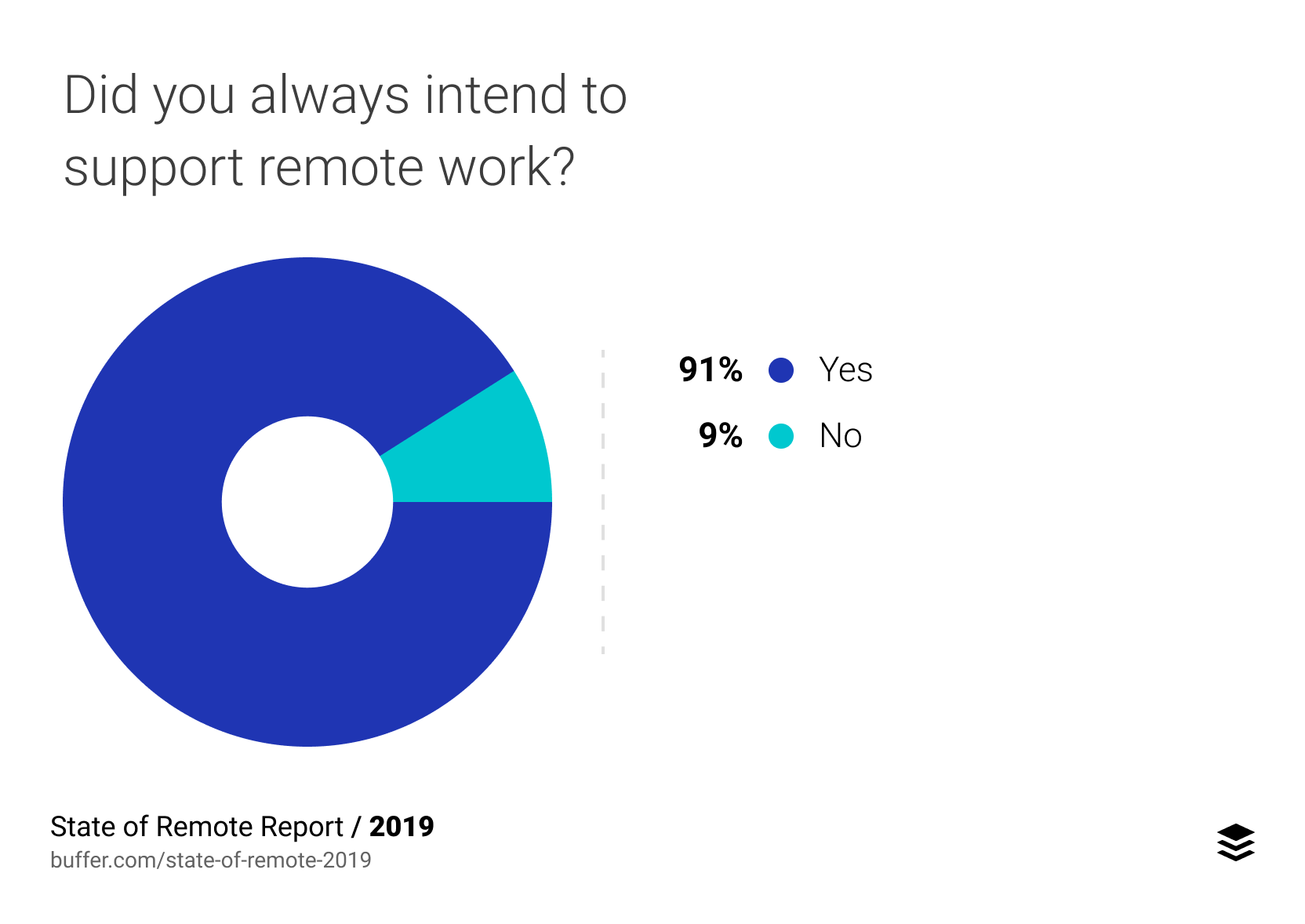
While fully remote companies (like Buffer) are the reality for 31% of respondents, an even greater 40% work on teams where part of the team is full-time remote, and the other part of the team works out of the same office. This leaves companies with the challenge of supporting both office and remote workers — employees who often have very different needs.

Hubstaff, a fully remote team that creates time tracking and productivity software, is familiar with the partially remote and partially office based set up through their customers. Their CEO, Dave Nevogt, believes that companies are catching on to all of the positive results that remote work brings to a business. “Businesses are continuing to embracing at least some form of remote work, likely because they’ve experienced the benefits of greater productivity, less wasted time, and lower overhead firsthand,” he says.
For these companies that balance both remote and in-office workers, there’s a big range when it comes to the percentage of the remote work contingent.
Almost the same amount of people reported that (a) all of their team works remotely and that (b) that less than 25% of them work remotely. The way these companies set up their teams really runs the gamut.


Most companies don’t pay for the costs associated with remote work like internet and coworking spaces.
While having teammates work remotely can help companies save money on office space and facilities, there are still costs associated with working remotely, such as home internet, coworking memberships and, yes, coffee.
Despite these costs, most companies don’t reimburse or cover them for remote workers. In fact, 75% of respondents said their company does not pay for home internet, and 71% said their company does not cover the cost of a coworking membership.

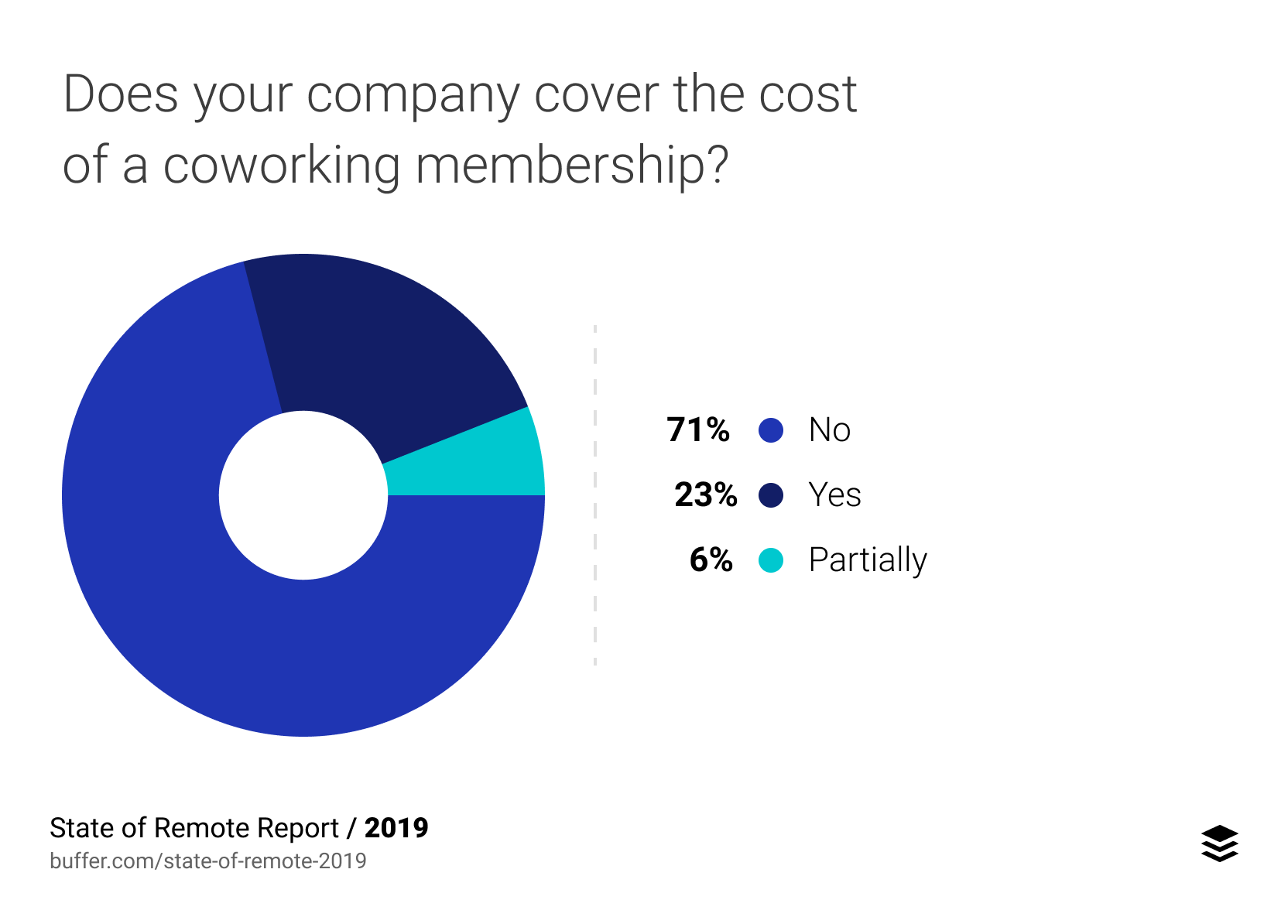

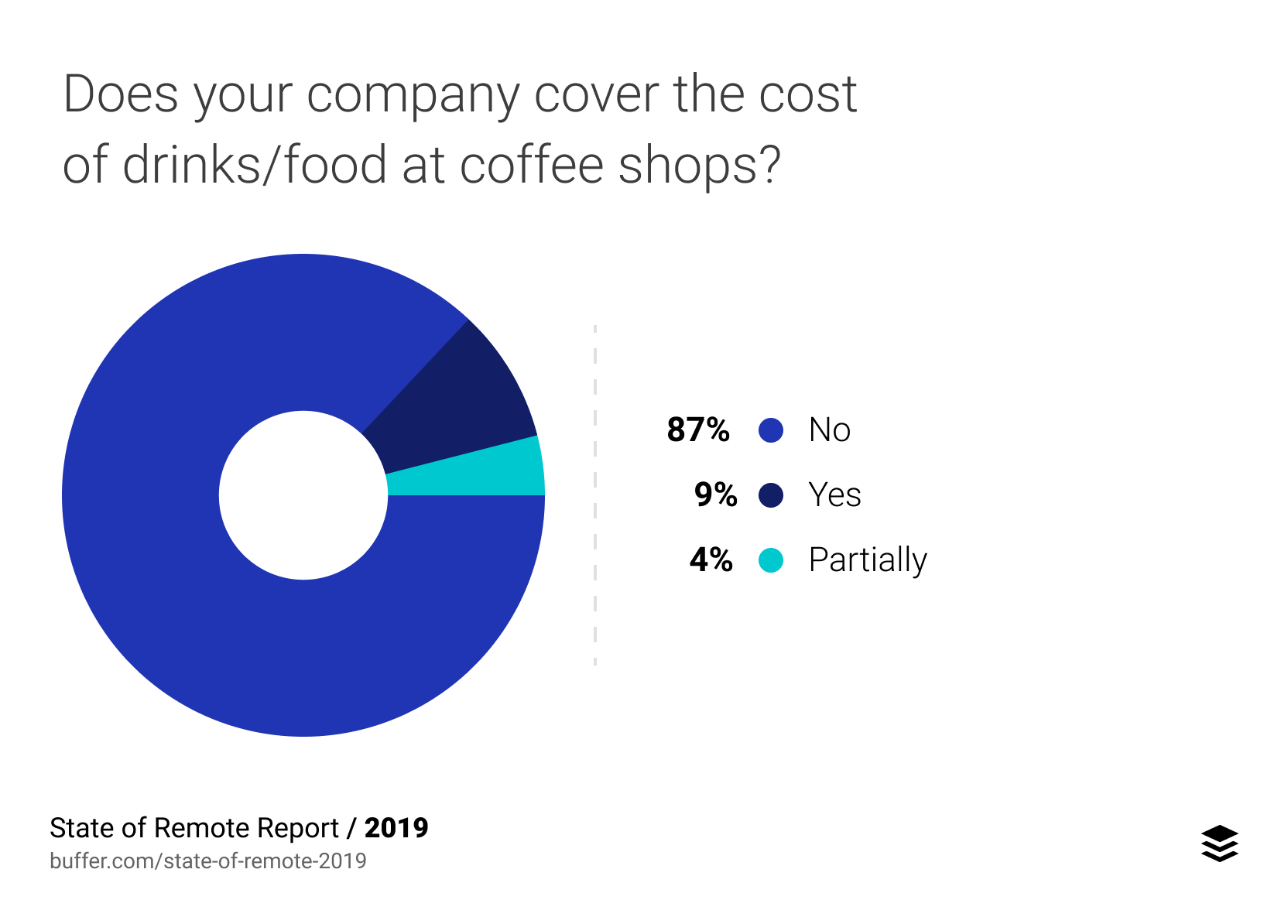

Adding a stipend for coffee shop coworking, as we call it at Buffer, was something our People team implemented just last year. Our Director of People, Courtney Seiter, explains that the decision came after realizing that several Buffer teammates preferred coffee shops as work spaces over their homes or coworking spaces. “We have always covered coworking spaces in an effort to help everyone on the team work where they are happiest and most productive. But we realized that coworking isn’t the right solution for everyone, so we expanded our co-working benefit to include coffee shop coworking,” she said.
About the data: Who took part in this survey?
In total, 2471 people responded to this survey.
Location by country
Forty-eight percent of respondents selected that they currently live in the United States, followed by Canada (6 percent), United Kingdom (6 percent) and Spain (4 percent). Other countries selected were: France (3 percent); Germany (3 percent); Ireland (Republic) (3 percent); India (2 percent); Australia (2 percent); Italy (1 percent; and the remaining 22 percent of countries had 1 percent or fewer respondents select them as options.
Industry breakdown
Thirty-eight percent of those who took the survey work at organizations in software space. Other industries include: IT and Services (18 percent); Marketing (12 percent); Other (7 percent); Media and Publishing (4 percent); Education (3 percent); E-commerce (3 percent); Non-profit (3 percent); Medical and Healthcare (2 percent); Travel and Tourism (2 percent); Consumer products (2 percent); Government (1 percent); and Law and Legal Services (0.5 percent).
Work experience
When asked about what best describes the work they do, 31 percent of respondents selected Engineering, followed by 18 percent of respondents choosing Marketing and Advertising. Other work options include: Leadership (8 percent); Design (7 percent); Other (7 percent); Operations (6 percent); Customer Support (6 percent); Product (5 percent); Human Resources (4 percent); Sales (3 percent); Data (3 percent); and Finances (1 percent.)
When asked about the level that they are in their current role, 34 percent of respondents selected Professional level, followed by 30 percent selecting Senior level. The next most selected response was Management level with 19 percent, Executive level with 12 percent, and finally Entry level with 5 percent having selected it.
Sixty-nine percent of respondents chose Employee as the term that best suited them. Of the remaining respondents, 22 percent chose Freelancer/Self-employed and 10 percent chose Business owner.
Remote work experience
The respondents to this survey have worked remotely for varying amounts of time, the most popular response was “1 year to 4 years” with 44 percent of respondents selecting it, followed by “more than 4 years” with 34 percent of respondents, and finally “6 months to 11 months” and “less than six months” were each selected by 11 percent of the respondents.
When asked which of the following statements best described them, 73 percent of respondents selected “I am happy with the amount of time I work remotely” followed by 20 percent selecting “I would like to work remotely more often” and the final 7 percent selecting “I would like to work remotely more often.”
Salary
Below is the breakdown of salary ranges for respondents in USD.
-
- $50,001 to $75,000 – 21%
- $75,001 to $100,000 – 19%
- $25,001 to $50,000 – 17%
- $100,000 to $125,000 – 12%
- up to $25,000 – 10%
- $125,001 to $150,000 – 10%
- $150,001 to $200,000 – 8%
- Over $200,000 – 4%
